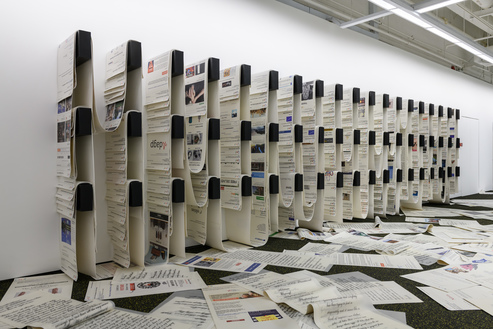-
From Current Issue
-
- Editor’s Letter Fire in the Heart
- Reviews I Gusti Ayu Kadek Murniasih
- Reviews 11th Seoul Mediacity Biennale: “One Escape at a Time”
- Dispatch Networked China
- One on One Monira Al Qadiri on Yukio Mishima
- Essays The rise of independent art spaces in pandemic-era Shanghai
- Features Tuan Andrew Nguyen
- Table of Contents
- Web Exclusives
- Archive
- Subscribe

R
E
V N
E
X
T
Installation view of “Dissolving Margins” at the Institute of Contemporary Arts Singapore, 2018–19. Photo by Weizhong Deng. All images courtesy the artists and the Institute of Contemporary Arts Singapore, unless otherwise stated.
Curated by Melanie Pocock, “Dissolving Margins” was inspired by Elena Ferrante’s four-part “Neapolitan Novels” series (2012–15). The books feature a protagonist who experiences multiple psychosomatic episodes, during which the outlines demarcating people and things dissolve and she is able to see the essence of what is in front of her. Bridging artworks of traditional and digital media, the show, presented at LASALLE’s Institute of Contemporary Arts Singapore, recreated the same experience, cutting to the core of life in the 21st century.
The three highlights of the exhibition were immediate attention grabbers. On one side of the gallery, four walls were transformed with the colors, texts and images of 365 posters that employ “ugly” design, involving the misalignment of images and text, inaccurate visualizations of spaces and the stretching of text to the point of illegibility. Studded among the printed posters were iPads featuring digital animations. Titled Autotypography (2012–13), Darius Ou’s installation is a potent attempt at creating a feeling of “conceptual chaos” from the “sheer variety of aesthetic,” in the words of the exhibition organizers. The whole display is jarring and overwhelming in a way that recalls online newsfeeds, giving pause to the fact that we ingest chaos without a thought every single day.
Next to Ou’s work, most of the floor was littered with Camille Henrot’s oversized prints bearing hundreds of spam emails, along with proposed replies written in cursive font. The prints that make up Office of Unreplied Emails (2016–17) also crept up onto a nearby wall and were draped on a succession of wooden racks over eight meters long. The unsettling feeling evoked by Ou’s work was relieved by Henrot’s tongue-in-cheek responses to the outlandish emails. Coupled with Eng Kai Er’s absurdist performance and video work Compressible Sentiments (2018), featuring the artist dancing in random local haunts such as a hawker center dressed in various ridiculous costumes, Henrot’s work added a touch of humor to the exhibition.
Across the room were four freestanding screens surrounding a viewing bench. The strongest work in the exhibition, visually and conceptually, James T. Hong’s Nietzsche Reincarnated as Chinese Woman and Their Shared Lives (2016–18) is adapted from a live performance first presented at the 10th Taipei Biennial by the artist. His film imagines the various beings that nihilist philosopher Friedrich Nietzsche has been reincarnated as following his death, including a single cell organism, invertebrate, insect and Chinese woman. Immersive shots are accompanied with haunting music from composer Giuseppe Verdi’s opera Don Carlos (1867), and a female narrator speaks about existentialist philosophies and their conflicting relationships to East Asian beliefs. You might think these 19th century references have little relevance today, but Hong proves otherwise. For example, he juxtaposes a shot of a single cell organism with a contemporary scene of crowds rushing across a train station in China, and an animal being slaughtered for consumption, with the line, “All these privileges and splendors. How much blood and horror lies at the basis of all ‘good things.’” In that moment, one is instinctively drawn beyond current realities to a point where life simultaneously begins and ends, allowing a glimpse into how far humanity has come and how much we have lost.
Installation view of JAMES T. HONG’s Nietzsche Reincarnated as a Chinese Woman and Their Shared Lives, 2016–18, four-channel, high-definition digital video installation with color and sound: 28 min 32 sec, at “Dissolving Margins,” Institute of Contemporary Arts Singapore, 2018–19.
“Dissolving Margins” stood out for its attempts in rethinking what it truly means to live in the contemporary era, when concurrent bursts of social, political and technological development and degradation spin us from the present toward the future.
“Dissolving Margins” is on view at the Institute of Contemporary Arts Singapore until January 22, 2019.
To read more of ArtAsiaPacific’s articles, visit our Digital Library.













